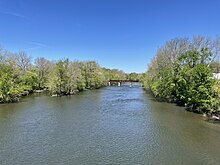Schuylkill River
It flows for 135 miles (217 km)[3] from Pottsville southeast to Philadelphia, the nation's sixth-largest city, where it joins the Delaware River as one of its largest tributaries.
The river's watershed of about 2,000 sq mi (5,180 km2) lies entirely within the state of Pennsylvania, stretching from the Ridge-and-Valley Appalachians through the Piedmont to the Atlantic Plain.
In 1682, William Penn founded the city of Philadelphia between the Schuylkill and Delaware rivers on lands purchased from the Lenape Indian tribe.
[6] According to John Heckewelder, a missionary who worked among the local Lenape Indians, the native name for the river was Ganshowe-hánne, meaning "roaring stream".
The Susquehannocks were an Iroquoian people also often in contention with their relatives:[9] the Erie people west and northwest through the gaps of the Allegheny in eastern Ohio and northwestern Pennsylvania (between the upper Allegheny River and Lake Erie), as well as the Five Nations of the Iroquois, another Amerindian confederation eastwards from the right bank of the Genesee River through the Finger Lakes region of upper New York down the St. Lawrence.
[10][11]>[12] American patriot paper maker Frederick Bicking owned a fishery on the river prior to the American Revolution, and Thomas Paine tried in vain to interest the citizens in funding an iron bridge over this river, before abandoning "pontifical works" on account of the French Revolution.
During the War of 1812, the two took delivery of an ark of anthracite coal which was notoriously difficult to combust reliably and experimented with ways to use it industrially, providing the knowledge to successfully begin resolving the ongoing decades long energy crises around eastern cities.
The success of these projects and the rosy promise of anthracite (a new wonder fuel in the day) to alleviate energy problems spurred canal construction for the next decade in the east, and commercial opportunities funded three decades of investment from Illinois to the Atlantic Ocean, including the ambitious 1824 Main Line of Public Works bill to connect Philadelphia with the newly emerging states of the Northwest Territory via the Allegheny & Ohio valleys at Pittsburgh and to Lake Erie— leveraging the wide-ranging branches of the Susquehanna River in the state's center.
In the 1830s railway technology and new railroads grew in leaps and bounds, and the Schuylkill Valley was at the heart of these developments, as well as the new Anthracite iron and mining industries.
Tiny farm villages grew into vibrant company towns then transitioned into small cities as a major industry and supporting businesses transformed local economics and populations swelled.
The rise of trucking capabilities and state & county development of road and highway networks progressively took increasing amounts of business away from both competing transport industries.
The zooming rise of automobile ownership post-World War II, the development of suburbs, and dispersal of industrial buildings into far flung parks serviced by the government supported highways and new Interstate Highways doomed intercity rail transport; even as Interstate Commerce Committee regulations required railway operating companies to maintain passenger rail services past its economic viability—which costs further imperiled the railroad's profits leading to a widespread collapse of the industry in the 1960s and 1970s.
The Schuylkill River Trail continues upriver from Norristown to Mont Clare, and designers plan to connect it to sections above Pottstown.
Above Reading, Pennsylvania Route 61 continues along the main river valley to Schuylkill Haven, then follows the east branch to Pottsville.
The trail presently runs from Philadelphia, through Manayunk to the village of Mont Clare, the latter of which are the locations of the last two remaining watered stretches of the Schuylkill Canal.
The Schuylkill River is the setting of the fictional estate White Acre in Elizabeth Gilbert's 2013 novel The Signature of All Things, based on The Woodlands.




